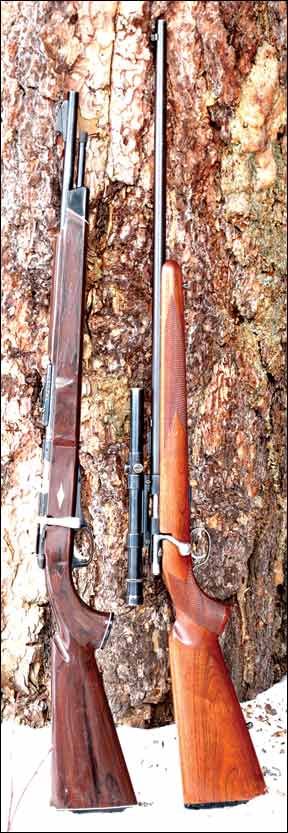For this test of vintage bolt-action 22 rifles, we had the loan of two old-timers, a Remington Nylon 12 and a Winchester Model 69A. We tested with three types of ammo, Wolf, CCI Velocitor, and Blazer, all in Long Rifle persuasion. Both rifles were supposed to handle Shorts and Longs too, so we also tried a few of them. Both rifles fed Long Rifles, Longs, Shorts and also CB caps perfectly. The Winchester’s longer barrel made lots less noise with Shorts and especially the CB caps than the Remington. The report of CB’s out of the long-barreled Winchester was just a click. Are these old rifles worth looking into? Let’s see what we found.

Remington Nylon 12 22 S, L, & LR, about $350
Made only from 1962 to 1964, the Remington Nylon 12 bolt action is a rare bird. This one had suffered a misfortune in storage, having got enough humidity on the metal to produce spotting on the bluing. A similar thing happened to an old Marlin belonging to one of our staff and it happened quickly. Not much can be done, short of spot rebluing to hide the damage, total rebluing (which could detract from its collector value), or leaving it strictly alone.
The stock had a few scratches, but was sound. The rifle had apparently never been fitted with a scope. It had grooves on the receiver for 22 scopes, and it also had one of the finest and simplest rear sights we’ve seen, fully adjustable and providing an excellent sight picture. We chose to test it as it was, no scope.
As noted, the metalwork had slight pits from damp storage, but about 85-90% of its original bluing remained. We thought the nylon stock could most likely be polished and renewed to some extent, maybe with good car polish or something similar, to remove a few of the scratches and provide some protection. The black butt plate was intact, and carried the Remington name. The checkering was excellent, we thought, obviously machine-made, but sharp enough to be useful to the shooter. The front-sight blade was non-ferrous metal tapering upward to about an eighth-inch thick on top, with a sharp-cut rear edge to give an excellent picture. The rear was a flat-top, square-notched, fully adjustable unit with a stamped steel base and a spring-steel standard, fixed to the barrel with two screws. To change elevation, turn a half-inch-diameter wheel. Spring force keeps the adjustments where you leave them. For windage, a smaller wheel moved the sight right or left by means of a tight worm screw. There were fine grooves for reference.
Removal of the bolt was by pressing the trigger, which also had to be pressed to reinsert it. The Winchester had the same setup. Loading was accomplished by twisting the tubular magazine follower and pulling it forward until the loading port in the stock was open. There was no stop on the follower tube, so the assembly can be pulled out if needed. A nice safety feature was that you could load the Nylon 12 with the bolt open and hence do so in perfect safety, and then close the bolt without picking up the first round from the tubular magazine. The mag held 13 Long Rifles in the tube, or 13+1 if need be. You can load a 14th round with the bolt open and the chamber empty. By cycling the bolt, the first round moves up to enter the chamber, making room for one more in the magazine. So if, for any reason, you want it fully loaded with 14 rounds, you can do so with a good degree of safety. A manual safety lock was at the right-rear corner. Move it rear to safe, and forward to fire. It prevented the rifle from firing but did not lock the bolt. The firing pin protruded when cocked, and was bright red.
We found the sight picture to be superb, though we blackened the rear face of the front sight to give a better reference. We spent 15 minutes removing old caked oil on the bolt and on the brass-tube feed. We brushed out the action workings as best we could, lightly lubed it, and then cleaned the barrel. We got some rust flakes out of the barrel, so we scrubbed it well with Kroil and then with Hoppe’s No. 9. On the range we shot a dozen shots and cleaned it again. The barrel looked okay, so we tried the first of our test ammunition. We then cleaned the barrel again and shot the rest of the test. To our surprise, given the state of the barrel initially, we got excellent accuracy with all three types of ammo. We wanted to try match ammo, but thought the rifle ought to be fitted with a scope for that, and we ran out of time and good weather. We thought the rifle had excellent balance.
The pull of the shiny trigger was crisp and clean, all you’d ever want, though it has lots of overtravel and was heavier than need be. We measured the break at 5.8 pounds. We fired the best group of the day with Blazers in the Nylon 12, five into 0.7 inch at 50 yards, but then we ran out of good light, our groups opened up, and we called it a day. All our groups, from the first to the last, were relatively round and tight, better than we had expected when we first saw that odd flake of rust come out of the barrel. By the end of our shoot, the barrel looked very good, with no evidence of pitting or roughness. Feeding was positive, ejection was strong, and there were no failures of any kind. We thought this was a light, handy, durable rifle well worth consideration if you come across one.
Our Team Said: All in all, we liked this rifle a lot. It may not win any beauty contests, unless beauty was judged by what we saw on the targets. These rifles go for about $400-$500 in excellent condition. It’s a pity this one had slightly damaged bluing. This rifle is not for sale, so don’t ask. The owner was given this Grade A rifle new, a long time ago, and he intends to keep it. We would, too, if we owned it.
Winchester Model 69A 22 S, L, LR, about $400
This old rifle had been upgraded with a few nice touches, including checkering. It sported an ancient 0.75-inch 4X Weaver B4 scope in Weaver Tip-Off mount, all in excellent condition. The scope provided a nice clean set of crosshairs. The rifle’s bluing was excellent, with very slight wear marks at the muzzle. The left side of the action had been drilled and tapped with four holes for an aperture sight, two of them apparently misdrilled and plugged with flush screws. The barrel was pristine inside. The rifle came to us with two five-round magazines. The magazine was released from the rifle by means of a button stuck into the wood on the left side of the rifle. A bit clumsy to insert or get out, they fed everything extremely well.
Unlike the Remington, the Winchester needed no preliminary cleaning. We ran a patch through the bore and took it to the range. The trigger pull of the Winchester was vastly superior to that of the Remington, with a crisp break of 1.9 pounds. With its perfect barrel, superb trigger pull and scope-sighted advantages we expected the Winchester to group better than the Remington, but it did so only with the Wolf ammo. We know this particular Winchester rifle has shot five target rounds into 0.33 inch at 50 yards. Could the Remington match that? With a good scope, a better trigger, and match ammo the Nylon 12 would be extremely interesting, we thought. Our smallest group with the scoped Winchester in this test was 1 inch, while the best one from the Remington with iron sights was 0.7 inch.
At 6.9 pounds this walnut-stocked rifle was a lot heavier than the Remington, which weighed 4.5 pounds. The main reason was the Winchester had a 25-inch barrel while the Nylon 12’s barrel was 19.5 inches long. Further, the Winchester’s tapered barrel was about 0.8 inches in diameter at the breech end, while the Remington’s straight one was only 0.63 inches. Please note that the long-er barrel of the Winchester did not give faster speeds with any of the test ammo. The main advantage of that long barrel is in target shooting with iron sights, where you get a long sight radius. The sight-adjustment mechanism of the Remington and its sight picture were superior to the iron sights on the Winchester. The M69A had a spring-type adjustment with stepped wedge for elevation, and by drifting for windage. The Winchester had a U-notch rear, and vague bead front sight, a combination that never gives precise elevation. Yet that setup is exactly what you get on many centerfire rifles today.
On the range we had no problems. Ejection was slightly weak, but if we worked the bolt harder, the empties flew out. The trigger was a dream, and the ancient scope was plenty good enough, we thought, and entirely appropriate for this vintage rifle. We liked this rifle, too. Its checkering was helpful, though you won’t get checkering on the one you buy from the local gun store. Original ones are uncheckered. Other custom touches included the trigger guard inletted into the wood, and some reshaping of the stock here and there. It also had a good oil finish and, we strongly suspect but could not confirm, a trigger job.
Our Team Said: We thought this was another good choice to look for at gun stores and gun shows if you’re in the market for an all-American 22 bolt rifle. For those of us who insist on walnut stocks, there’s no choice here — the Winchester wins hands down — but we found both of these rifles well worth considering if you’re after a vintage, U.S.-made rimfire rifle. We gave this one an A grade, too.
Written and photographed by Ray Ordorica, using evaluations from Gun Tests team testers. GT



























